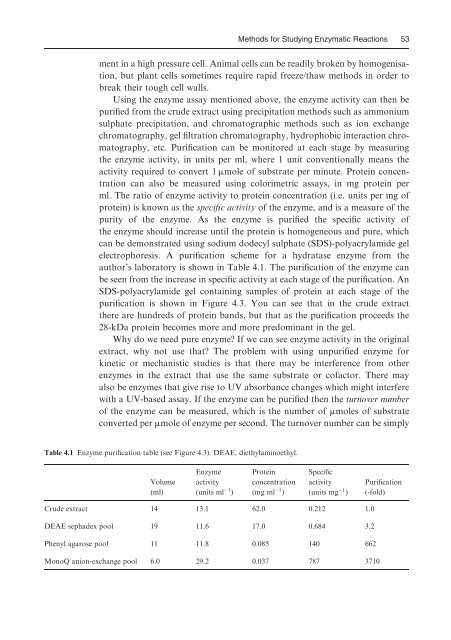Introduction to Enzyme and Coenzyme Chemistry - E-Library Home
Introduction to Enzyme and Coenzyme Chemistry - E-Library Home
Introduction to Enzyme and Coenzyme Chemistry - E-Library Home
You also want an ePaper? Increase the reach of your titles
YUMPU automatically turns print PDFs into web optimized ePapers that Google loves.
Methods for Studying Enzymatic Reactions 53<br />
ment in a high pressure cell. Animal cells can be readily broken by homogenisation,<br />
but plant cells sometimes require rapid freeze/thaw methods in order <strong>to</strong><br />
break their <strong>to</strong>ugh cell walls.<br />
Using the enzyme assay mentioned above, the enzyme activity can then be<br />
puriWed from the crude extract using precipitation methods such as ammonium<br />
sulphate precipitation, <strong>and</strong> chroma<strong>to</strong>graphic methods such as ion exchange<br />
chroma<strong>to</strong>graphy, gel Wltration chroma<strong>to</strong>graphy, hydrophobic interaction chroma<strong>to</strong>graphy,<br />
etc. PuriWcation can be moni<strong>to</strong>red at each stage by measuring<br />
the enzyme activity, in units per ml, where 1 unit conventionally means the<br />
activity required <strong>to</strong> convert 1 mmole of substrate per minute. Protein concentration<br />
can also be measured using colorimetric assays, in mg protein per<br />
ml. The ratio of enzyme activity <strong>to</strong> protein concentration (i.e. units per mg of<br />
protein) is known as the speciWc activity of the enzyme, <strong>and</strong> is a measure of the<br />
purity of the enzyme. As the enzyme is puriWed the speciWc activity of<br />
the enzyme should increase until the protein is homogeneous <strong>and</strong> pure, which<br />
can be demonstrated using sodium dodecyl sulphate (SDS)-polyacrylamide gel<br />
electrophoresis. A puriWcation scheme for a hydratase enzyme from the<br />
author’s labora<strong>to</strong>ry is shown in Table 4.1. The puriWcation of the enzyme can<br />
be seen from the increase in speciWc activity at each stage of the puriWcation. An<br />
SDS-polyacrylamide gel containing samples of protein at each stage of the<br />
puriWcation is shown in Figure 4.3. You can see that in the crude extract<br />
there are hundreds of protein b<strong>and</strong>s, but that as the puriWcation proceeds the<br />
28-kDa protein becomes more <strong>and</strong> more predominant in the gel.<br />
Why do we need pure enzyme If we can see enzyme activity in the original<br />
extract, why not use that The problem with using unpuriWed enzyme for<br />
kinetic or mechanistic studies is that there may be interference from other<br />
enzymes in the extract that use the same substrate or cofac<strong>to</strong>r. There may<br />
also be enzymes that give rise <strong>to</strong> UV absorbance changes which might interfere<br />
with a UV-based assay. If the enzyme can be puriWed then the turnover number<br />
of the enzyme can be measured, which is the number of mmoles of substrate<br />
converted per mmole of enzyme per second. The turnover number can be simply<br />
Table 4.1 <strong>Enzyme</strong> puriWcation table (see Figure 4.3). DEAE, diethylaminoethyl.<br />
Volume<br />
(ml)<br />
<strong>Enzyme</strong><br />
activity<br />
(units ml 1 )<br />
Protein<br />
concentration<br />
(mg ml 1 )<br />
SpeciWc<br />
activity<br />
(units mg 1 )<br />
PuriWcation<br />
(-fold)<br />
Crude extract 14 13.1 62.0 0.212 1.0<br />
DEAE sephadex pool 19 11.6 17.0 0.684 3.2<br />
Phenyl agarose pool 11 11.8 0.085 140 662<br />
MonoQ anion-exchange pool 6.0 29.2 0.037 787 3710



